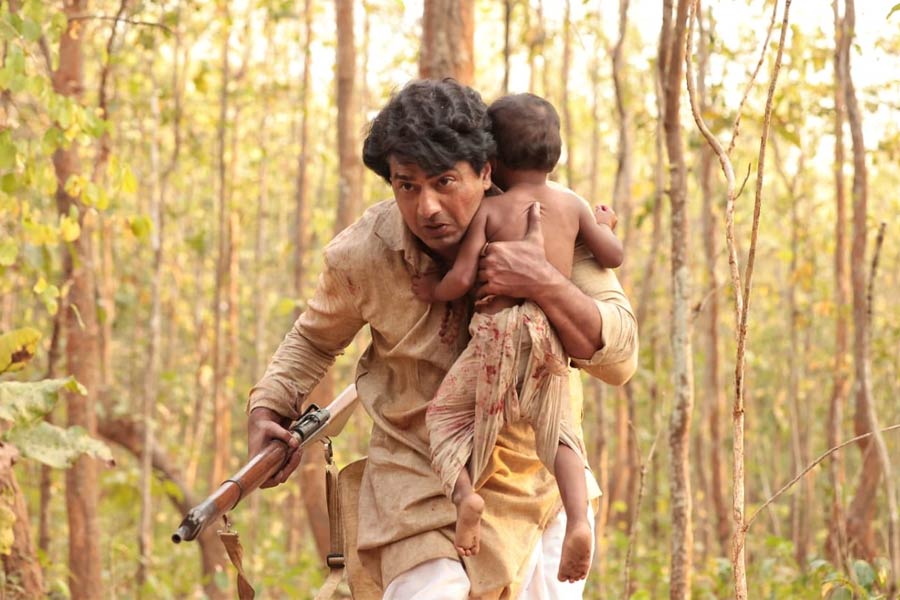Ah, the pleasures of watching Dev. There are no surprises when you enter the dark interiors of a theatre for a film headlined by this star. You pretty much get what you expect. You get Dev. So, Nagendrapasad Sarbadhikari in Golondaaj is Dev. (And not the other way round as it probably should be.) As is Byomkesh Bakshi in Byomkesh O Durgo Rahasya, earlier this year. And he continues to be Dev in Bagha Jatin. Only the period changes from his earlier capers like Cockpit and Kidnap. As I wrote in another review of a Dev potboiler, he occupies that rarefied space every star aspires to where he or his films are impervious to reviews. And yes, it is quite impossible to be harsh about Dev, even when his film falters.
Well, Bagha Jatin falters. And how. This is one of the greatest freedom fighters Bengal has produced. By the time Jatindranath Mukherjee died in a gunfight with British troops in the jungles of Balasore in 1915, at the age of 36, he was a legend, a name feared and respected in equal measure. He was associated with almost all the major anti-British activities in the first 15 years of the 20th century. It is kind of uncanny how his death coincided with the homecoming of Mohandas Karamchand Gandhi and how that altered the way we went about the business of fighting for our freedom.
Yet, people outside Bengal may well have not heard about this extraordinary revolutionary. Even within the state it is debatable how many of us are aware of his life beyond the legend of how he got his name. That then is Arun Roy’s project. To introduce the audience to these hallowed names: Prafulla Chaki, Khudiram Bose, Barindra Ghosh, Anushilan Samiti, Jugantar, among others. And as far as that is concerned, he goes about his job in a workmanlike manner, providing what is at best a potted history of the time and the man. If you have read the Wikipedia entry about Bagha Jatin, you know more or less everything that the film has. For that matter, it also quotes a conversation from the entry verbatim.
This is history for the MCU generation, leached of all nuances. So, you have a freedom fighter in the early 20th Century engaging in fistfights that would do a Peter Hein proud. You have bodies flying and spiralling in air much like you get in the ubiquitous Telugu films – many of them action-choreographed by Hein – dubbed in Hindi that are so popular on the telly.
You have the first sight of the man – only his feet, mind you, anything more than that will just not do for an introduction – emerging in slow-mo. You have him in slow-mo every now and then, even if the shot has him simply walking away. And all that to the accompaniment of what is supposed to be an inspirational song and pulsating background music but sounds like a chant from Singham. You have him mouthing, repeatedly, what the filmmakers clearly expect will elicit whistles and claps, bringing the house down: ‘Jatin Mukherjee hoy loray noy moray (Jatin Mukherjee knows how to fight or die)’. In short you have everything about the man except a real understanding of what made him what he was.
There are fascinating facets to the man that either don’t get a mention – dabbling in acting and caricature, his apprenticeship under Swami Vivekananda which shaped his world view – or are not explored in any depth, for example, the relationship with supercop Charles Tegart, who held him in grudging admiration. It is not possible for a film to encapsulate all details in the life and times of a man like Bagha Jatin, but surely, the writing can go beyond the obvious and provide a glimpse of the man under the freedom fighter. Arun Roy is clearly not walking that path.
Which is sad because Arun Roy made the understated ‘8/12 Binoy Badal Dinesh’ a couple of years ago, throwing light on a group of revolutionaries from Bengal very few are aware of. There was something rather affecting about the film despite its static telling. I put that down to budgetary constraints, but obviously the budget wasn’t an issue here. This film has everything a Bengali film budget can buy, except imagination. When a filmmaker relentlessly employs pulse-pounding music to convey emotions in the narrative, you know there’s not much of that going around. And when a filmmaker falls back on large passages of voiceover narration to give the background to what is unfolding on screen, you can only shake your head at the failure to understand the requirements of a visual medium.
But then, maybe I am being unduly harsh. This is after all a Dev film. I went into it looking for Bagha Jatin as Dev. I got that. What more can I ask for?
Shantanu Ray Chaudhuri is a film and music buff, editor, publisher, film critic and writer











